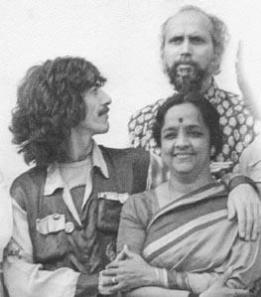The Beatles and North Indian Classical Music
From “the Role of The Beatles in Popularizing Indian Music and Culture in the West
by Rodrigo Guerrero
The Owl – The Florida State University Undergraduate Research Journal
By 1964, Paul McCartney, John Lennon, George Harrison, and Ringo Starr – a group of young musicians from Liverpool, England, who called themselves the Beatles – were the protagonists of a world phenomenon known as Beatlemania; which alludes to the unprecedented levels of fame and commercial success that the band [had] obtained. Moreover, the Beatles had become ‘a kind of spirit-level for trends in popular music, and were widely imitated in dress, attitude, and musical style.’ In 1966, still at the peak of their popularity, the group decided to stop performing live and focused their attention on exploring new compositional and recording techniques in the studio. This led to what is often considered their most innovative and artistically accomplished period.

“Among the various results that this Beatles’ musical experimentation yielded, the group’s venture into Indian musical element stands out as particularly influential, but also unexpected. How did a British pop group become interested in Indian culture? George Harrison described it himself:
“We were waiting to shoot the scene in the restaurant [for their movie Help! 1965]… and there were a few Indian musicians playing in the background. I remember picking up the sitar and trying to hold it, and thinking, ‘This is a funny sound.’ It was an incidental thing, but somewhere down the line I began to hear Ravi Shankar’s name…
“In fact, Harrison met with sitar player Ravi Shankar – who by the mid-1960s had established himself as the most successful Indian musician in the West – and the maestro agreed to give sitar lessons to Harrison. In September 1966, Harrison would end up flying to Bombay to further his studies with Shankar for six weeks.
“A year later, on August 24, 1967, Maharishi Mahesh Yogi (1917-2008), an Indian guru (spiritual leader or master in Indian religions) and the founder of the Transcendental Meditation movement, gave a lecture in London, and Harrison took his band mates along to hear him speak. After meeting the Maharishi, the Beatles decided to travel to his academy in Rishikesh, India, to learn amore about Transcendental Meditation. In February 1968, the group flew to India to participate in a six-week retreat. Although intended to be private, the event, nevertheless, caught the press’ attention. Although the trip abruptly ended after a dispute between John Lennon and the Maharishi, the fact that the most popular rock group in the world took six weeks to travel to India for learning purposes shows that their interest in Indian music and culture was genuine.
“When the Beatles’ sixth studio album Rubber Soul was released in December 1965, the world was caught by surprise when the second track of the record was introduced by a sound that most fans had not heard before. The Lennon song ‘Norwegian Wood’, was the first pop record to include a sitar on it. As innovative as the inclusion of the sitar was, it was only used to double the acoustic guitar in the song’s still traditionally Western melody…
“The Beatles’ next album, Revolver (1966), featured a song that was a significant change from what Harrison had done a few months earlier in ‘Norwegian Wood’. ‘Love You To’ was the first of George’s songs to be composed entirely on the sitar. The song was modeled after North Indian classical music, and the recording features Indian musicians playing tanpura (plucked string instrument) and table (percussion instrument), with Harrison on the sitar and lead vocals. Moreover, the melodic material derives from the raga Kafi that… The second song of George Harrison’s Indian trilogy, ‘Within You Without You’ (1967), is the most complex composition of the three. The song features Indian instruments played by Indian musicians and a Western string ensemble playing in conversational texture (call and response interaction among instruments). [Gerry] Farrell notes that ‘within the space of five minutes Harrison makes reference to an assortment of Indian musical genres: khyal… bhajan… filmi…..’ This song also uses traditional Indian rhythmic patterns. Harrison recalls, ‘The best part for me was the instrumental solo in the middle which is in 5/4 time, the first strange rhythmic cycles I caught onto…
“Even though the Indian influence on the Beatles is mostly evident in George Harrison’s Indian trilogy, many of their post-1966 songs include Indian musical elements that often go unnoticed. Some of these songs include: ‘Tomorrow Never Knows’ (1966), ‘Strawberry Fields Forever’ (1967), ‘Lucy in the Sky with Diamonds’ (1967), ‘Across the Universe’ (1967) and ‘Here Comes the Sun’ (1969). ‘Strawberry Fields Forever’, perhaps one of their most accomplished singles, features a swarmandal (a string instrument in Hindustani music similar to a harp) in an otherwise pop/rock song. While ‘Here Comes the Sun’, of Harrison’s most popular songs, does not incorporate Indian instruments, it uses 11/8 and 7/8 time signatures in a manner commonly found in Indian classical music.”
Raga is a 1971 documentary film about the life and music of Indian sitarist Ravi Shankar, produced and directed by Howard Worth.
George Harrison: Living in the Material World is a 2011 documentary film co-produced and directed by Martin Scorsese, based on the life of George Harrison.
